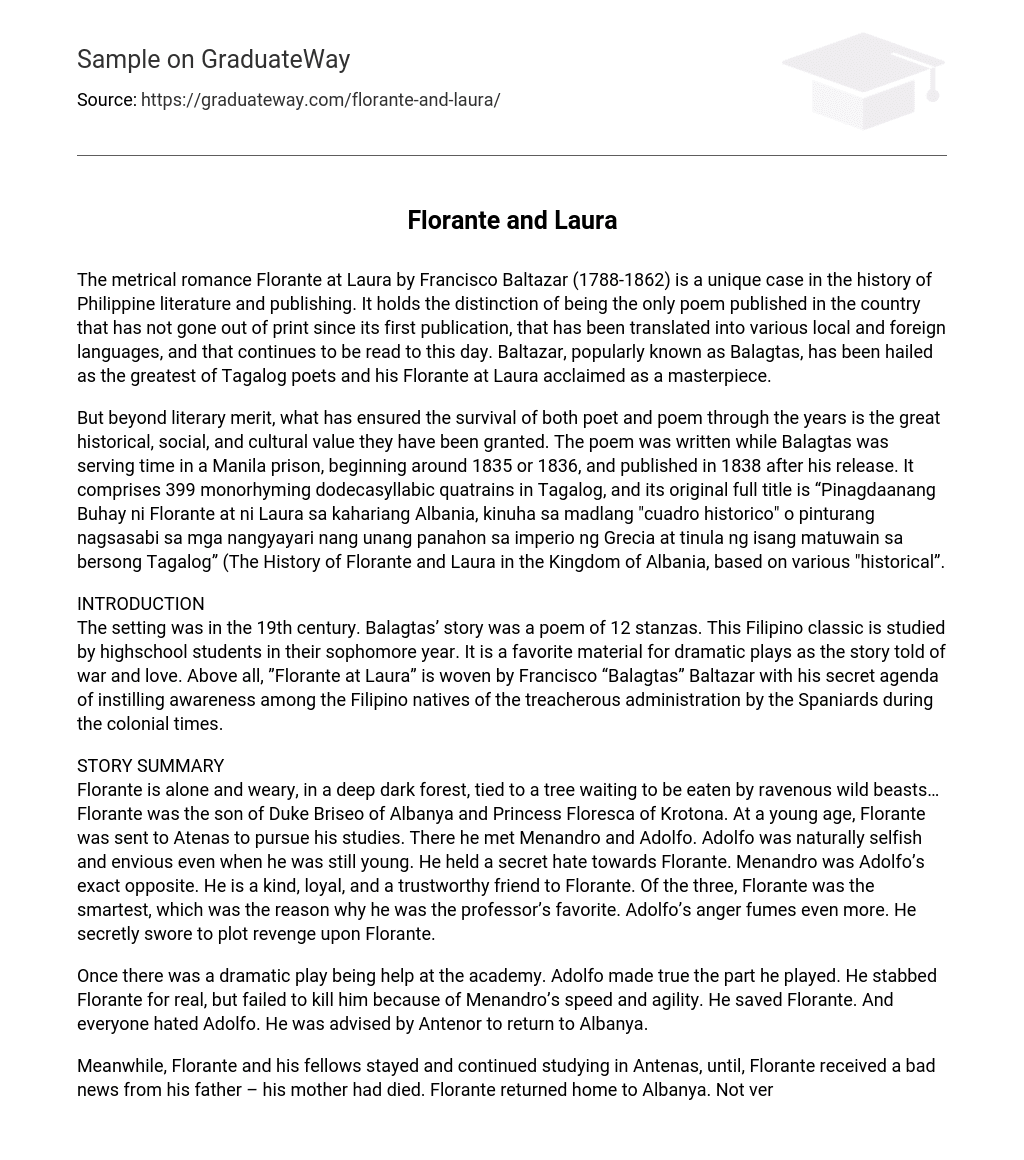The metrical romance “Florante at Laura” by Francisco Baltazar (1788-1862) is a unique case in the history of Philippine literature and publishing. It holds the distinction of being the only poem published in the country that has not gone out of print since its first publication, has been translated into various local and foreign languages, and continues to be read to this day. Baltazar, popularly known as Balagtas, has been hailed as the greatest of Tagalog poets, and his “Florante at Laura” acclaimed as a masterpiece.
But beyond literary merit, what has ensured the survival of both poet and poem through the years is the great historical, social, and cultural value they have been granted. The poem was written while Balagtas was serving time in a Manila prison, beginning around 1835 or 1836, and published in 1838 after his release. It comprises 399 monorhyming dodecasyllabic quatrains in Tagalog, and its original full title is “Pinagdaanang Buhay ni Florante at ni Laura sa kahariang Albania, kinuha sa madlang ‘cuadro historico’ o pinturang nagsasabi sa mga nangyayari nang unang panahon sa imperio ng Grecia at tinula ng isang matuwain sa bersong Tagalog” (The History of Florante and Laura in the Kingdom of Albania, based on various “historical”).
Introduction
The setting was in the 19th century. Balagtas’ story was a poem of 12 stanzas. This Filipino classic is studied by high school students in their sophomore year. It is a favorite material for dramatic plays as the story tells of war and love. Above all, “Florante at Laura” is woven by Francisco “Balagtas” Baltazar with his secret agenda of instilling awareness among the Filipino natives of the treacherous administration by the Spaniards during the colonial times.
Story Summary
Florante is alone and weary in a deep, dark forest, tied to a tree waiting to be eaten by ravenous wild beasts. Florante was the son of Duke Briseo of Albania and Princess Floresca of Krotona. At a young age, Florante was sent to Athens to pursue his studies. There he met Menandro and Adolfo. Adolfo was naturally selfish and envious even when he was still young. He held a secret hate towards Florante. Menandro was Adolfo’s exact opposite. He was a kind, loyal, and trustworthy friend to Florante. Of the three, Florante was the smartest, which was the reason why he was the professor’s favorite. Adolfo’s anger fumed even more, and he secretly swore to plot revenge upon Florante.
Once there was a dramatic play being held at the academy. Adolfo made true the part he played. He stabbed Florante for real, but failed to kill him because of Menandro’s speed and agility. He saved Florante, and everyone hated Adolfo. He was advised by Antenor to return to Albania.
Meanwhile, Florante and his companions stayed and continued their studies in Antenas until Florante received bad news from his father: his mother had passed away. Florante then returned home to Albanya. It wasn’t long before his father, the duke, introduced him to the king, and this was when Florante first laid eyes on Laura, the beautiful daughter of King Linseo. Even though it was only their eyes that met, the hearts of Florante and Laura instantly and clearly understood each other. They loved each other from then on. However, Florante had to go to Krotona, where his grandfather ruled. King Linseo of Albanya assigned Florante to come to the aid of the warring Krotona, and with God’s help, Florante succeeded. He saved Krotona from the Moors.
Unfortunately, when Florante returned to Albania, he discovered that the kingdom was in peril. The Moors had imprisoned his father and even Adolfo. Nonetheless, Florante saved them all and freed the prisoners once again. King Linseo loved Florante even more, and Florante’s deeds became famous overseas.
Anyway, the four lovers all meet and try to catch up on old times. They were still chatting when they were found by Menandro and his army, who were out searching for Adolfo. The army rejoices when they find out that Florante and Laura are still alive. Not long after, Florante and Laura marry and rule Albania as King and Queen. Aladin and Flerida get baptized, marry, and then return to Persia to rule their land.
Reaction
The story also wanted to impart to us that love conquers all, and this love could give us the strength to fight for the person we really love. This story was said to be the result of the heartache that Baltazar received after losing the woman he loved the most, Maria Asuncion Rivera, to a rich and powerful man named Mariano Capule. Rivera was said to be the woman whom Baltazar referred to as “Celia” and “MAR” in his poem. Florante at Laura was also written as a depiction of the country’s situation during the rule of the Spaniards. The poem shows that religious differences should not be used to discriminate against one another.





